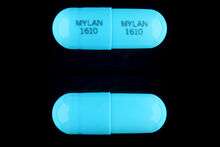Dicycloverine
Dicycloverine, also known as dicyclomine, is a medication that is used to treat spasms of the intestines such as occur in irritable bowel syndrome.[1][2] It is taken by mouth or by injection into a muscle.[2] While it has been used in baby colic and enterocolitis, evidence does not support these uses.[2]
 | |
| Clinical data | |
|---|---|
| Trade names | Byclomine, Bentyl, Dibent, others |
| AHFS/Drugs.com | Monograph |
| MedlinePlus | a684007 |
| License data | |
| Pregnancy category | |
| ATC code | |
| Legal status | |
| Legal status | |
| Pharmacokinetic data | |
| Protein binding | >99% |
| Elimination half-life | 5 h |
| Identifiers | |
| |
| CAS Number | |
| PubChem CID | |
| IUPHAR/BPS | |
| DrugBank | |
| ChemSpider | |
| UNII | |
| KEGG | |
| ChEBI | |
| ChEMBL | |
| CompTox Dashboard (EPA) | |
| ECHA InfoCard | 100.000.919 |
| Chemical and physical data | |
| Formula | C19H35NO2 |
| Molar mass | 309.494 g·mol−1 |
| 3D model (JSmol) | |
| |
| |
| (verify) | |
Common side effects include dry mouth, blurry vision, weakness, sleepiness, and lightheadedness.[2] Serious side effects may include psychosis and breathing problems in babies.[2] Use in pregnancy appears to be safe while use during breastfeeding is not recommended.[3] How it works is not entirely clear.[2]
Dicycloverine was approved for medical use in the United States in 1950.[2] It is available as a generic medication.[1] In 2017, it was the 181st most commonly prescribed medication in the United States, with more than three million prescriptions.[4][5]
Medical uses
Dicyclomine is used to treat the symptoms of irritable bowel syndrome, specifically hypermotility, in adults.[6][7] As of 2016, clinical guidelines recommended dicycloverine and other antispasmodics for IBS with diarrhea as a first line treatment, although the evidence for their effectiveness was very weak.[6]
Contraindications
This medicine should not be used for people who have an obstructive GI or urinary condition, severe ulcerative colitis, reflux, any unstable cardiac condition, glaucoma, myasthenia gravis, and anyone who is acutely bleeding.[7]
It should not be given to children or infants with colic due to the risks of convulsions, difficult breathing, irritability, and restlessness,[8] and there is little evidence to support the efficacy in such use in any case.[9]
Because dicycloverine is known to impair thinking and coordination, people taking the drug should avoid driving or operating machinery.[7]
The effect on the baby during pregnancy or breastfeeding is not well understood.[7]
Adverse effects
Dicycloverine can cause a range of anticholinergic side effects such as dry mouth, nausea, blurred vision, dizziness, confusion, severe constipation, stomach pain, heart palpitations, difficulty urinating, and seizures.[6]
Pharmacology
Dicycloverine blocks the action of acetylcholine on cholinergic receptors on smooth muscles in the GI tract, relaxing the smooth muscle.[6]
History

Dicycloverine was first synthesized chemically in the United States circa 1945 by scientists at William S. Merrell Company.[10]
It was first marketed in 1952 for gastrointestinal disorders, including colic in infants.[8] The INN name "dicycloverine" was recommended in 1959.[11] It was included in the combination drug for morning sickness called Bendectin, along with doxylamine and vitamin B6 which was launched in the US 1956; dicyclomine was removed from the formulation in 1976 after Merrell determined that it added no value. Bendectin became the subject of many lawsuits due to allegations that it had caused birth defects similar to thalidomide, which Merrell had also marketed in the US and Canada.[12]
In the mid 1980s several governments restricted its use in infants due to reports of convulsions, difficult breathing, irritability, and restlessness in infants given the drug.[8]
In 1994 the US Federal Trade Commission ordered Marion Merrell Dow, which had recently acquired Rugby Darby, the only generic manufacturer of dicycloverine in the US, to promise to grant licenses to its intellectual property on the drug to any company that wanted it, based on antitrust concerns. The US market for the drug at that time was around $8 million; Dow had 60% of it and Rugby had 40%. The next year, Hoechst Marion Roussel, which by that time had acquired the business, granted a license to Endo Pharmaceuticals. By 2000 several other generic competitors had started selling the drug. The case was part of the reshaping of the US pharmaceutical market that occurred in the 1990s, to favor generic entry.[13]
Society and culture
There are reports of dicycloverine abuse, but they are rare.[6]
References
- British national formulary : BNF 76 (76 ed.). Pharmaceutical Press. 2018. p. 759. ISBN 9780857113382.
- "Dicyclomine Hydrochloride Monograph for Professionals". Drugs.com. American Society of Health-System Pharmacists. Retrieved 3 March 2019.
- "Dicyclomine Pregnancy and Breastfeeding Warnings". Drugs.com. Retrieved 3 March 2019.
- "The Top 300 of 2020". ClinCalc. Retrieved 11 April 2020.
- "Dicyclomine Hydrochloride - Drug Usage Statistics". ClinCalc. Retrieved 11 April 2020.
- Canadian Agency for Drugs and Technologies in Health (3 December 2015). "Dicyclomine for Gastrointestinal Conditions: A Review of the Clinical Effectiveness, Safety, and Guidelines". CADTH Rapid Response Reports. PMID 26985553.

- AHFS Staff (2006). "Dicyclomine hydrochloride". AHFS DI Essentials. Bethesda, MD: American Society of Health-System Pharmacists / drugs.com. Retrieved November 25, 2018.
- Consolidated List of Products Whose Consumption and/or Sale Have Been Banned, Withdrawn, Severely Restricted or Not Approved by Governments (PDF) (12 ed.). World Health Organization. 2005. p. 106. Retrieved November 25, 2018.
- Biagioli E, Tarasco V, Lingua C, Moja L, Savino F (September 2016). "Pain-relieving agents for infantile colic". The Cochrane Database of Systematic Reviews. 9: CD009999. doi:10.1002/14651858.CD009999.pub2. hdl:2434/444531. PMC 6457752. PMID 27631535.

- "Dicyclomine". Pubchem. Retrieved November 25, 2018.
- "International Nonproprietary Names for Pharmaceutical Preparations List #3" (PDF). WHO Chronicle. 13 (12): 463–474. December 1959. Retrieved November 25, 2018.
- Sanders J (January 1992). "The Bendectin Litigation: A Case Study in the Life Cycle of Mass Torts" (PDF). Hastings Law Journal. 43 (2): 317. Retrieved November 25, 2018.
- Chien C (2003). "Cheap Drugs at What Price to Innovation: Does the Compulsory Licensing of Pharmaceuticals Hurt Innovation?". Berkeley Technology Law Journal. 18 (3): 853–907. JSTOR 24116860.